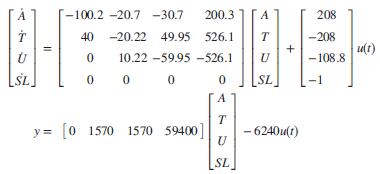The basic unit of skeletal and cardiac muscle cells is a sarcomere, which is what gives such
Question:
The basic unit of skeletal and cardiac muscle cells is a sarcomere, which is what gives such cells a striated (parallel line) appearance. For example, one bicep cell has about 105 sarcomeres. In turn, sarcomeres are composed of protein complexes. Feedback mechanisms play an important role in sarcomeres and thus muscle contraction. Namely, Fenn’s law says that the energy liberated during muscle contraction depends on the initial conditions and the load encountered. The following linearized model describing sarcomere contraction has been developed for cardiac muscle:

where
A = density of regulatory units with bound calcium and adjacent weak cross bridges (μM)
T = density of regulatory units with bound calcium and adjacent strong cross bridges (M)
U = density of regulatory units without bound calcium and adjacent strong cross bridges (M)
SL = sarcomere length (m)
The system’s input is u(t) = the shortening muscle velocity in meters/second and the output is y(t) = muscle force output in Newtons (Yaniv, 2006).
Do the following:
a. Use MATLAB to obtain the transfer function Y(s)/U(s).
b. Use MATLAB to obtain a partial fraction expansion for Y(s)/U(s).
c. Draw a signal-flow diagram of the system in parallel form.
d. Use the diagram of Part c to express the system in state-variable form with decoupled equations.
Step by Step Answer:





